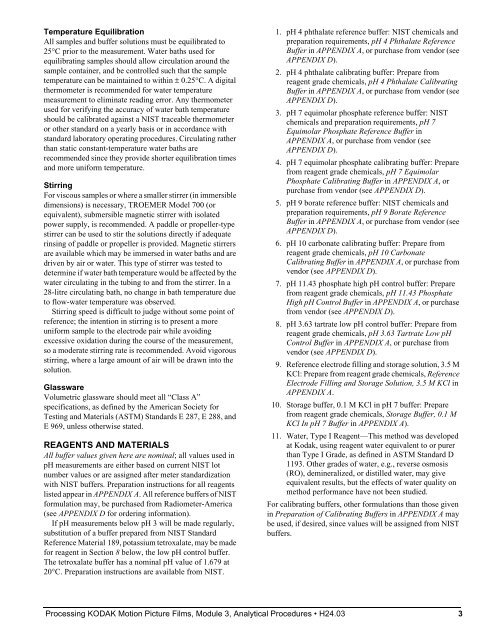Processing kodak motion picture films, module 3 analytical procedures
Processing kodak motion picture films, module 3 analytical procedures
Processing kodak motion picture films, module 3 analytical procedures
You also want an ePaper? Increase the reach of your titles
YUMPU automatically turns print PDFs into web optimized ePapers that Google loves.
Temperature Equilibration<br />
All samples and buffer solutions must be equilibrated to<br />
25°C prior to the measurement. Water baths used for<br />
equilibrating samples should allow circulation around the<br />
sample container, and be controlled such that the sample<br />
temperature can be maintained to within ± 0.25°C. A digital<br />
thermometer is recommended for water temperature<br />
measurement to eliminate reading error. Any thermometer<br />
used for verifying the accuracy of water bath temperature<br />
should be calibrated against a NIST traceable thermometer<br />
or other standard on a yearly basis or in accordance with<br />
standard laboratory operating <strong>procedures</strong>. Circulating rather<br />
than static constant-temperature water baths are<br />
recommended since they provide shorter equilibration times<br />
and more uniform temperature.<br />
Stirring<br />
For viscous samples or where a smaller stirrer (in immersible<br />
dimensions) is necessary, TROEMER Model 700 (or<br />
equivalent), submersible magnetic stirrer with isolated<br />
power supply, is recommended. A paddle or propeller-type<br />
stirrer can be used to stir the solutions directly if adequate<br />
rinsing of paddle or propeller is provided. Magnetic stirrers<br />
are available which may be immersed in water baths and are<br />
driven by air or water. This type of stirrer was tested to<br />
determine if water bath temperature would be affected by the<br />
water circulating in the tubing to and from the stirrer. In a<br />
28-litre circulating bath, no change in bath temperature due<br />
to flow-water temperature was observed.<br />
Stirring speed is difficult to judge without some point of<br />
reference; the intention in stirring is to present a more<br />
uniform sample to the electrode pair while avoiding<br />
excessive oxidation during the course of the measurement,<br />
so a moderate stirring rate is recommended. Avoid vigorous<br />
stirring, where a large amount of air will be drawn into the<br />
solution.<br />
Glassware<br />
Volumetric glassware should meet all “Class A”<br />
specifications, as defined by the American Society for<br />
Testing and Materials (ASTM) Standards E 287, E 288, and<br />
E 969, unless otherwise stated.<br />
REAGENTS AND MATERIALS<br />
All buffer values given here are nominal; all values used in<br />
pH measurements are either based on current NIST lot<br />
number values or are assigned after meter standardization<br />
with NIST buffers. Preparation instructions for all reagents<br />
listed appear in APPENDIX A. All reference buffers of NIST<br />
formulation may, be purchased from Radiometer-America<br />
(see APPENDIX D for ordering information).<br />
If pH measurements below pH 3 will be made regularly,<br />
substitution of a buffer prepared from NIST Standard<br />
Reference Material 189, potassium tetroxalate, may be made<br />
for reagent in Section 8 below, the low pH control buffer.<br />
The tetroxalate buffer has a nominal pH value of 1.679 at<br />
20°C. Preparation instructions are available from NIST.<br />
1. pH 4 phthalate reference buffer: NIST chemicals and<br />
preparation requirements, pH 4 Phthalate Reference<br />
Buffer in APPENDIX A, or purchase from vendor (see<br />
APPENDIX D).<br />
2. pH 4 phthalate calibrating buffer: Prepare from<br />
reagent grade chemicals, pH 4 Phthalate Calibrating<br />
Buffer in APPENDIX A, or purchase from vendor (see<br />
APPENDIX D).<br />
3. pH 7 equimolar phosphate reference buffer: NIST<br />
chemicals and preparation requirements, pH 7<br />
Equimolar Phosphate Reference Buffer in<br />
APPENDIX A, or purchase from vendor (see<br />
APPENDIX D).<br />
4. pH 7 equimolar phosphate calibrating buffer: Prepare<br />
from reagent grade chemicals, pH 7 Equimolar<br />
Phosphate Calibrating Buffer in APPENDIX A, or<br />
purchase from vendor (see APPENDIX D).<br />
5. pH 9 borate reference buffer: NIST chemicals and<br />
preparation requirements, pH 9 Borate Reference<br />
Buffer in APPENDIX A, or purchase from vendor (see<br />
APPENDIX D).<br />
6. pH 10 carbonate calibrating buffer: Prepare from<br />
reagent grade chemicals, pH 10 Carbonate<br />
Calibrating Buffer in APPENDIX A, or purchase from<br />
vendor (see APPENDIX D).<br />
7. pH 11.43 phosphate high pH control buffer: Prepare<br />
from reagent grade chemicals, pH 11.43 Phosphate<br />
High pH Control Buffer in APPENDIX A, or purchase<br />
from vendor (see APPENDIX D).<br />
8. pH 3.63 tartrate low pH control buffer: Prepare from<br />
reagent grade chemicals, pH 3.63 Tartrate Low pH<br />
Control Buffer in APPENDIX A, or purchase from<br />
vendor (see APPENDIX D).<br />
9. Reference electrode filling and storage solution, 3.5 M<br />
KCl: Prepare from reagent grade chemicals, Reference<br />
Electrode Filling and Storage Solution, 3.5 M KCl in<br />
APPENDIX A.<br />
10. Storage buffer, 0.1 M KCl in pH 7 buffer: Prepare<br />
from reagent grade chemicals, Storage Buffer, 0.1 M<br />
KCl In pH 7 Buffer in APPENDIX A).<br />
11. Water, Type I Reagent—This method was developed<br />
at Kodak, using reagent water equivalent to or purer<br />
than Type I Grade, as defined in ASTM Standard D<br />
1193. Other grades of water, e.g., reverse osmosis<br />
(RO), demineralized, or distilled water, may give<br />
equivalent results, but the effects of water quality on<br />
method performance have not been studied.<br />
For calibrating buffers, other formulations than those given<br />
in Preparation of Calibrating Buffers in APPENDIX A may<br />
be used, if desired, since values will be assigned from NIST<br />
buffers.<br />
<strong>Processing</strong> KODAK Motion Picture Films, Module 3, Analytical Procedures H24.03 3
















